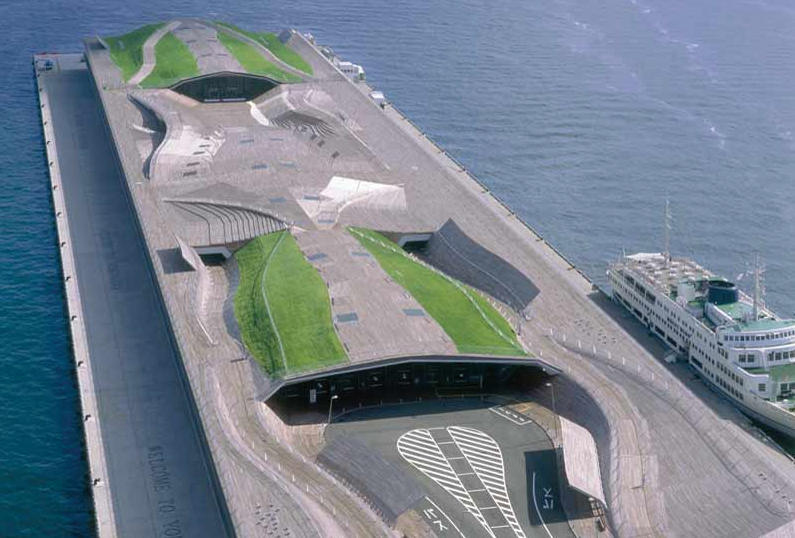A fascinating day at Japan's second largest city, only 30 minutes south of Tokyo by (heat-seated!) train. Actually it was impossible to see where one city ended and the other began...
Yokohama, we learned, had a very interesting history. A village until 1859, it was opened up that year as the first Japanese port in which foreign ships could dock. This is evident from the European-influenced architecture, for example in the columned porticos and use of brick. As a result of foreign trade, the village grew into a city, only to be devastated by an earthquake in 1923; only 8 buildings survived. Having rebuilt itself, the city suffered decimation once more in 1945 when it was bombed by the US. At this point, only 30 buildings, that had been constructed between 1859 and 1945, remained. Following the war, the US used Yokohama as an army base.
 |
| Yokohama International Ferry Terminal |
Now the city is branding itself as 'Creative City Yokohama', home to many contemporary artists and Foreign Office Architect's Yohomana International Ferry Terminal. And we immediately got a sense of laid-back creativity as soon as we stepped out of the station. A contrast to Tokyo, the streets were uncrowded, and there was a noticeable lack of neon and noise!
Our first meeting was at the Urban Renaissance Agency (UR). This social housing developer owns 24% of public houses in Japan and our meeting with the person responsible for consulting and engaging with residents of new developments was extremely interesting and very relevant to the work we are doing at TBE. I only wish my colleague Karen had been there! We were told about how the UR was established in 1955 as a result of national policy to solve Japan's housing shortage, especially in urban areas. The organisation responds to changes in demographics and the economic climate, which are currently very similar to the issues we face in England; an ageing population and
recession. A further complication is that as the Japanese are having much smaller families, there is an overall fall in the number of households. UR are aware that they need to diversify their housing stock to meet these changes in requirements, although they aim to maintain existing buildings as far as possible rather than demolish and rebuild.
UR's main objectives in terms of creating new developments are safe residents, supporting children, community cohesion, providing outdoor space and supporting older people. This last objective is of particular relevance to our plans at TBE, so I was interested to hear that the organisation has
an 'Age-in-Place' programme which supports older people to live in their own house for as long as possible, through adapting existing housing and providing support advisors.
The UR director then talked us through a case study of community engagement around the redevelopment of Tamadaira Housing Complex in Tokyo. They explained how existing residents were involved in the development from start to finish, from initial meetings with the city council and developers, to consultation workshops over the course of a year, in which they learned about architecture and green spaces and made suggestions for changes to original plans, some of which were integrated into the housing schemes. Community activities facilitated by UR, such as craft activities, summer festivals and exhibitions, continue long after the completion of building
work.
The model of community engagement and participation to which UR has been working for 15 years, is one which we at TBE aspire to. It was fantastic to hear of a developer (albeit a publicly funded one) embracing this model. The benefits of working in this way, as articulated by UR, are familiar and
obvious: residents are much less resistant to changes they feel a part of, and take a much more active part in maintaining the new development.
After a delicious Bento box in the spacious and very trendy art space next door to UR's offices, we headed to BankArt, yet another fantastic and super-cool art space!
 |
| BankArt 1929, Yokohama |
At BankArt, we met the Culture Director from Yokohama City Council, who gave us a fascinating and detailed overview of Yokohama Creative City, a strategy designed to combat Japan's economic, demographic and social (Japan has a suicide rate 3 times higher than UK and does not even register on the Gross National Happiness indicator scale) problems. The strategy includes encouraging creative industries into the area through offering very cheap studio space, four publicly owned art spaces and many creative public programmes and events, including sending artists to work in 50 primary
schools (an idea they got from the British Council). This year's theme is 'Everyone is an artist', and again, it was fantastic to hear of a local government recognising the importance of creativity and culture and making such a big investment in this area.
The director of BankArt talked us through the work of the space and its many exciting projects, following which we were shown round the huge, concrete studios, where people were rehearsing for a multi-space dance performance, and we met some London-based artists who were installing an enormous map for the delivery of an architecture workshop. Strangely, one of the artists
lives 5 minutes down the road from me...it's a small world!
 |
| Our host, Dr Aya Sakai with Bridget, Mark and Cara |
Down in the cafe it was time to thank Dr Aya Sakai who, over the week, had shown extreme patience in helping us buy train tickets, escorting us everywhere, answering our many questions and tirelessly translating for us (as a result of translating our presentations, Aya knows as much about UK
built environment learning activity as we do!). For our last meal, we headed to Yokohama's Chinatown (the biggest outside China!) and, yet again, ate very very well! And then back to our hotel in Tokyo, for a final goodbye drink with my fantastic learning colleagues from the ACN, Bristol
and Southampton.


























